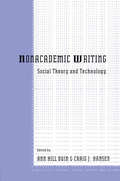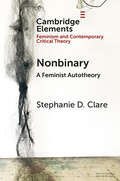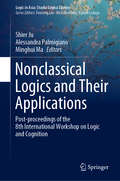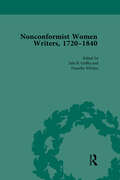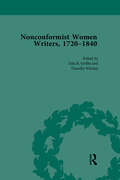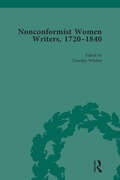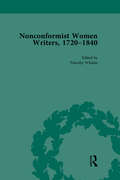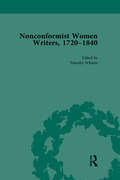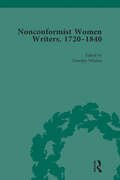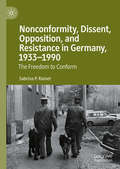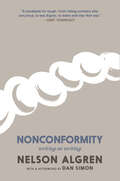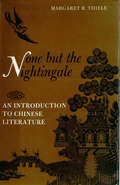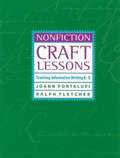- Table View
- List View
Nonacademic Writing: Social Theory and Technology
by Ann Hill DuinIn this volume, methodological, cultural, technological, and political boundaries felt by writers are analyzed, translated, and challenged in a way that will appeal to researchers, theorists, graduate students, instructors, and managerial audiences. Instead of extracting rules from previous research, the contributors, working from multidisciplinary perspectives, describe and analyze the social and technological contexts surrounding nonacademic writing. Their essays present a formative rather than summative outlook toward future research on nonacademic writing. Collectively, these chapters articulate a unique perspective toward nonacademic writing that considers: * The centrality of emerging communications technologies in nonacademic writing research and the need for a socio-technological perspective. New technologies reshape the concept of text and significantly impact the writing process and written products in nonacademic settings. * The relationship between the academy and the workplace. A number of chapters challenge us -- sometimes from opposing perspectives -- to scrutinize our role as writing educators in preparing students for the workplace. Should we support the interests of corporate employers, or should we resist those interests? Should we enculturate students in workplace writing practices by placing them in these environments, or should we examine the tacit knowledge gained by workplace professionals and deliver this via classroom instruction? * New theory, new research agendas. Contributors from diverse fields offer new theoretical lenses or use established lenses in innovative ways, expanding the agenda for nonacademic writing research. This volume represents the vision the social landscape demands for research and pedagogy in nonacademic writing.
Nonbinary: A Feminist Autotheory (Elements in Feminism and Contemporary Critical Theory)
by Stephanie D. ClareThis autotheoretical Element, written in the tense space between feminist and trans theory, argues that movement between 'woman' and 'nonbinary' is possible, affectively and politically. In fact, a nonbinary structure of feeling has been central in the history of feminist thought, such as in Simone de Beauvoir's The Second Sex (1949). This structure of feeling is not antifeminist but indexical of a desire for a form of embodiment and relationality beyond binary sex and gender. Finally, the Element provides a partial defense of nonbinary gender identity by tracing the development of the term in online spaces of the early 2000s. While it might be tempting to read its development as symptomatic of the forms of selfhood reproduced in (neo)liberal, racialized platform capitalism, this reading is too simplistic because it misses how the term emerged within communities of care.
Nonclassical Logics and Their Applications: Post-proceedings of the 8th International Workshop on Logic and Cognition (Logic in Asia: Studia Logica Library)
by Shier Ju Alessandra Palmigiano Minghui MaThis edited book focuses on non-classical logics and their applications, highlighting the rapid advances and the new perspectives that are emerging in this area. Non-classical logics are logical formalisms that violate or go beyond classical logic laws, and their specific features make them particularly suited to describing and reason about aspects of social interaction. The richness and diversity of non-classical logics mean that this area is a natural catalyst for ideas and insights from many different fields, from information theory to game theory and business science. This volume is the post-proceedings of the 8th International Conference on Logic and Cognition, held at Sun Yat-Sen University Institute of Logic and Cognition (ILC) in Guangzhou, China in December 2016. The conference series started in 2001, and is organized by the ILC, often in collaboration with various international research groups. This eighth installment was jointly organized by ILC and Alessandra Palmigiano's Applied Logic research group. The conference series aims to foster the development of effective logical tools to study social behavior from a philosophical, cognitive and formal perspective in order to challenge the field of logic in ways that open up new and exciting research directions.Chapter "The Category of Node-and-Choice Forms, with Subcategories for Choice-Sequence Forms and Choice-Set Forms" of this book is available open access under a CC BY 4.0 license at link.springer.com
Nonconformist Women Writers, 1720-1840, Part I Vol 1
by Timothy Whelan Julia B. GriffinThese volumes will present, in some cases for the first time, the lives and works of a coterie of Nonconformist women writers from the West Country.
Nonconformist Women Writers, 1720-1840, Part I Vol 2
by Timothy Whelan Julia B. GriffinThese volumes will present, in some cases for the first time, the lives and works of a coterie of Nonconformist women writers from the West Country.
Nonconformist Women Writers, 1720-1840, Part I Vol 3
by Timothy WhelanThese volumes will present, in some cases for the first time, the lives and works of a coterie of Nonconformist women writers from the West Country.
Nonconformist Women Writers, 1720-1840, Part I Vol 4
by Timothy WhelanThese volumes will present, in some cases for the first time, the lives and works of a coterie of Nonconformist women writers from the West Country.
Nonconformist Women Writers, 1720-1840, Part II vol 5
by Timothy WhelanThese volumes will present, in some cases for the first time, the lives and works of a coterie of Nonconformist women writers from the West Country.
Nonconformist Women Writers, 1720-1840, Part II vol 6
by Timothy WhelanThese volumes will present, in some cases for the first time, the lives and works of a coterie of Nonconformist women writers from the West Country.
Nonconformist Women Writers, 1720-1840, Part II vol 7
by Timothy WhelanThese volumes will present, in some cases for the first time, the lives and works of a coterie of Nonconformist women writers from the West Country.
Nonconformist Women Writers, 1720-1840, Part II vol 8
by Timothy WhelanThese volumes will present, in some cases for the first time, the lives and works of a coterie of Nonconformist women writers from the West Country.
Nonconformity, Dissent, Opposition, and Resistance in Germany, 1933-1990: The Freedom to Conform
by Sabrina P. Ramet“This book brings fresh light to previously marginalized subject in German history. It is an original approach, up-to-date written without scholarly jargon, easily accessible to students, both at undergraduate and graduate. It is highly focused departing from the usual “histories” of a single country arguing for the “two German states”, and the three political systems.”- Prof. Dr. László Kürti, Institute of Applied Social Sciences, University of Miskolc, HungaryThis book contrasts three very different incarnations of Germany – the totalitarian Third Reich, the communist German Democratic Republic, and the democratic Federal Republic of Germany up to 1990 – in terms of their experiences with and responses to nonconformity, dissent, opposition, and resistance and the role played by those factors in each case. Although even innocent nonconformity came with a price in all three systems and in the post-war occupation zones, the price was the highest in Nazi Germany. . It is worth stressing that what qualifies as nonconformity and dissent depends on the social and political context and, thus, changes over time. Like those in active dissent, opposition, or resistance, nonconformists are rebels (whether they are conscious of it or not), and have repeatedly played a role in pushing for change, whether through reform of legislation, transformation of the public’s attitudes, or even regime change.
Nonconformity: Writing on Writing
by Nelson AlgrenThe struggle to write with deep emotion is the subject of this extraordinary book, the previously unpublished credo of one of America's greatest 20th-century writers."You don't write a novel out of sheer pity any more than you blow a safe out of a vague longing to be rich," writes Nelson Algren in his only longer work of nonfiction, adding: "A certain ruthlessness and a sense of alienation from society is as essential to creative writing as it is to armed robbery." Nonconformity is about 20th-century America: "Never on the earth of man has he lived so tidily as here amidst such psychological disorder." And it is about the trouble writers ask for when they try to describe America: "Our myths are so many, our vision so dim, our self-deception so deep and our smugness so gross that scarcely any way now remains of reporting the American Century except from behind the billboards . . . [where there] are still . . . defeats in which everything is lost [and] victories that fall close enough to the heart to afford living hope." In Nonconformity, Algren identifies the essential nature of the writer's relation to society, drawing examples from Dostoyevsky, Chekhov, Twain, and Fitzgerald, as well as utility infielder Leo Durocher and legendary barkeep Martin Dooley. He shares his deepest beliefs about the state of literature and its role in society, along the way painting a chilling portrait of the early 1950s, Joe McCarthy's heyday, when many American writers were blacklisted and ruined for saying similar things to what Algren is saying here.
None but the Nightingale: An Introduction to Chinese Literature
by Margaret ThieleThis classic introduction to the Chinese literature is a fundamental step towards the West's understanding of the rich literary legacy of China.<P><P>Readable, condensed, entertaining, the selections contained in this book belong to enduring world literature; the "Great Society" envisioned by Confucius; the "Fireside Chats" of K'ang Hei; the supercilious letter of the Emperor Ch'ien Lung to King George of England; the "Memorial: on the Bone of Buddha"; the imaginative lines of the poets.The wit and wisdom of China dispel time and distance and bring East and West together as the heart and soul of a great people is revealed in their stories, anecdotes, essays, and poems. Here is a close-up view of the educational system, home life, and government of old China as found in their own writings, with personal glimpses of some of the great--the emperors bathing in their crystal pools, of Lao Tzu in his library, and Confucius in his fur-lined underwear. found in their own writings, with personal glimpses of some of the great--the emperors bathing in their crystal pools, of Lao Tzu in his library, and Confucius in his fur-lined underwear.
Nonfiction Craft Lessons Teaching Information Writing K-8
by Ralph Fletcher Joann PortalupiThis book will help students breathe voice into lifeless dump-truck writing and improve their nonfiction writing by making it clearer, more authoritative, and more organized. Nonfiction Craft Lessons gives teachers a wealth of practical strategies to help students grow into strong writers as they explore and explain the world around them.
Nonhuman Agencies in the Twenty-First-Century Anglophone Novel
by Yvonne Liebermann Judith Rahn Bettina BurgerThis book offers an overview on the growing field of nonhuman studies in relation to Anglophone novels. It illuminates the variety of nonhuman actors that take centre stage in the twenty-first-century novel and the formal changes that the Anthropocene, the digital turn, the animal rights movement, and research into plant consciousness have brought to the novel as a form. The book is divided into four sections, each focusing on a different aspect of twenty-first-century literature that engages with the nonhuman. The collection investigates how the environmental changes and the increasing use of AI technologies have fostered the flourishing of genres like the New Weird, Climate Fiction, and speculative fiction, how it makes us embrace new perceptions of life in relation to genetic engineering, and how it forces us to engage with newly emerging political contexts.
Nonlinear Temporality in Joyce and Walcott: History Repeating Itself with a Difference (Routledge Studies in Twentieth-Century Literature)
by Sean SeegerNonlinear Temporality in Joyce and Walcott is the first dedicated comparative study of James Joyce and Derek Walcott. The book examines the ways in which both Joyce’s fiction and Walcott’s poetry articulate a nonlinear conception of time with radical cultural and political implications. For Joyce and Walcott equally, the book argues, it is only by reconceiving time in this way that it becomes possible to envisage a means of escape from what Joyce calls “force, hatred, history” and what Walcott calls the “madness of history seen as sequential time”. A starting point for the comparisons drawn between Joyce and Walcott is their relationship to Homer. Joyce’s Ulysses is in one respect a rewriting of Homer’s Odyssey; Walcott’s Omeros stands in an analogous relationship to the Iliad. This book argues that these acts of rewriting, far from being instances of influence, intertexuality, or straightforward repetition, exemplify Joyce and Walcott’s complex stance, not just toward literary history, but toward the idea of history as such. The book goes on to demonstrate how an enhanced appreciation of the role of nonlinear temporality in Joyce and Walcott can help to illuminate numerous other aspects of their work.
Nonnative Speaker English Teachers: Research, Pedagogy, and Professional Growth (ESL & Applied Linguistics Professional Series)
by George BraineAccording to current estimates, about eighty percent of English teachers worldwide are nonnative speakers of the language. The nonnative speaker movement began a decade ago to counter the discrimination faced by these teachers and to champion their causes. As the first single-authored volume on the topic since the birth of the movement, this book fills the need for a coherent account that: traces the origins and growth of the movement summarizes the research that has been conducted highlights the challenges faced by nonnative speaker teachers promotes NNS teachers’ professional growth. No discussion of world Englishes or the spread of English internationally is now complete without reference to the NNS movement. This book celebrates its first decade and charts a direction for its growth and development.
Nonprofit Communications: A Mission-Driven and Human-Centered Approach
by Kelly C. GagginThis text provides a guide to strategic communications for nonprofit organizations that is rooted in the desire to serve and do good.Acknowledging that nonprofit organizations, like commercial businesses, cannot succeed without a communications strategy that supports their overall business goals, seasoned practitioner and educator Kelly C. Gaggin explores the industry in a way that nurtures the servant’s heart while clearly discussing the business structure of nonprofits and the need (in most cases) to earn revenue to provide services. She teaches a strategic and integrated approach to communications that is mission-based and human-centric to align the values of the nonprofit sector with the campaign planning process. This text offers a view of nonprofits at local, national, and international levels of impact and explores those relationships while keeping in mind the value and needs of those being served.This book is an indispensable text for undergraduate and graduate courses in nonprofit strategic communications and/or management as well as an essential resource for nonprofit industry professionals.Online resources also accompany this text. For instructors: lecture slides, syllabus, chapter quizzes. For students: planning templates for DEEEM model. Please visit www.routledge.com/9781032461144.
Nonrequired Reading
by Wislawa Szymborska Clare CavanaghWislawa Szymborska's poems are admired around the world, and her unsparing vision, tireless wit, and deep sense of humanity are cherished by countless readers. Unknown to most of them, however, Szymborska also worked for several decades as a columnist, reviewing a wide variety of books under the unassuming title "Nonrequired Reading." As readers of her poems would expect, the short prose pieces collected here are anything but ordinary. Reflecting the author's own eclectic tastes and interests, the pretexts for these ruminations range from books on wallpapering, cooking, gardening, and yoga, to more lofty volumes on opera and world literature. Unpretentious yet incisive, these charming pieces are on a par with Szymborska's finest lyrics, tackling the same large and small questions with a wonderful curiosity.
Nonsense and Meaning in Ancient Greek Comedy
by Stephen E. KiddThis book examines the concept of 'nonsense' in ancient Greek thought and uses it to explore the comedies of the fifth and fourth centuries BCE. If 'nonsense' (phluaria, lēros) is a type of language felt to be unworthy of interpretation, it can help to define certain aspects of comedy that have proved difficult to grasp. Not least is the recurrent perception that although the comic genre can be meaningful (i. e. contain political opinions, moral sentiments and aesthetic tastes), some of it is just 'foolery' or 'fun'. But what exactly is this 'foolery', this part of comedy which allegedly lies beyond the scope of serious interpretation? The answer is to be found in the concept of 'nonsense': by examining the ways in which comedy does not mean, the genre's relationship to serious meaning (whether it be political, aesthetic, or moral) can be viewed in a clearer light.
Nonverbal Communication
by Laura K. Guerrero Judee K Burgoon Valerie ManusovThe newly revised edition of this groundbreaking textbook provides a comprehensive overview of the theory, research, and applications of nonverbal communication. Authored by three of the foremost scholars in the field and drawing on multidisciplinary research from communication studies, psychology, linguistics, and family studies, Nonverbal Communication speaks to today’s students with modern examples that illustrate nonverbal communication in their lived experiences. It emphasizes nonverbal codes as well as the functions they perform to help students see how nonverbal cues work with one another and with the verbal system through which we create and understand messages and shows how consequential nonverbal means of communicating are in people’s lives. Chapters cover the social and biological foundations of nonverbal communication as well as the expression of emotions, interpersonal conversation, deception, power, and influence. This edition includes new content on “Influencing Others,” as well as a revised chapter on “Displaying Identities, Managing Images, and Forming Impressions” that combines identity, impression management, and person perception. Nonverbal Communication serves as a core textbook for undergraduate and graduate courses in communication and psychology. Online resources for instructors, including an extensive instructor’s manual with sample exercises and a test bank, are available at www.routledge.com/9780367557386
Nonverbal Communication
by Laura K. Guerrero Kory Floyd Judee K BurgoonDrawing significantly on both classic and contemporary research, Nonverbal Communication speaks to today’s students with modern examples that illustrate nonverbal communication in their lived experiences. This new edition, authored by three of the foremost scholars in nonverbal communication, builds on the approach pioneered by Burgoon, Buller and Woodall which focused on both the features and the functions that comprise the nonverbal signaling system. Grounded in the latest multidisciplinary research and theory, Nonverbal Communication strives to remain very practical, providing both information and application to aid in comprehension.
Nonverbal Communication in Close Relationships
by Laura K. Guerrero Kory FloydNonverbal Communication in Close Relationships provides a synthesis of research on nonverbal communication as it applies to interpersonal interaction, focusing on the close relationships of friends, family, and romantic partners. Authors Laura K. Guerrero and Kory Floyd support the premise that nonverbal communication is a product of biology, social learning, and relational context. They overview six prominent nonverbal theories and show how each is related to bio-evolutionary or sociocultural perspectives. Their work focuses on various functions of nonverbal communication, emphasizing those that are most relevant to the initiation, maintenance, and dissolution of close relationships. Throughout the book, Guerrero and Floyd highlight areas where research is either contradictory or inconclusive, hoping that in the years to come scholars will have a clearer understanding of these issues. The volume concludes with a discussion of practical implications that emerge from the scholarly literature on nonverbal communication in relationships – an essential component for understanding relationships in the real world. Nonverbal Communication in Close Relationships makes an important contribution to the development of our understanding not only of relationship processes but also of the specific workings of nonverbal communication. It will serve as a springboard for asking new questions and advancing new theories about nonverbal communication. It is intended for scholars and advanced students in personal relationship study, social psychology, interpersonal communication, nonverbal communication, family studies, and family communication. It will also be a helpful resource for researchers, clinicians, and couples searching for a better understanding of the complicated roles that nonverbal cues play in relationships.
